Prostration, Praise and Prayers — the most essential practices for busy Buddhists. “Go Bananas” for Buddha: Devotion
“Go bananas for the Buddha, “is sage advice for any practitioner, new and advanced students alike.
The great teacher Dzongsar Khyentse Rinpoche once described devotion in a talk on Tara:
“The devotees of Tara, especially the devotees from great universities like as Nalanda, they go bananas. They long for her, they praise to her, they really supplicate, they beseech her.”
Longing and love and passion and wonder are methods. We need to praise, adore, pray, prostrate — not just for merit and purification, but to come closer to that ultimate truth that: “The deity is none other than the union of clarity and emptiness, the union of emptiness and compassion.” [2]
Rinpoche was explaining the importance and power of devotion and love — to go bananas for your deity. It can be as simple as that for those of us not yet ready to become a yogi or yogini and retreat to a cave.
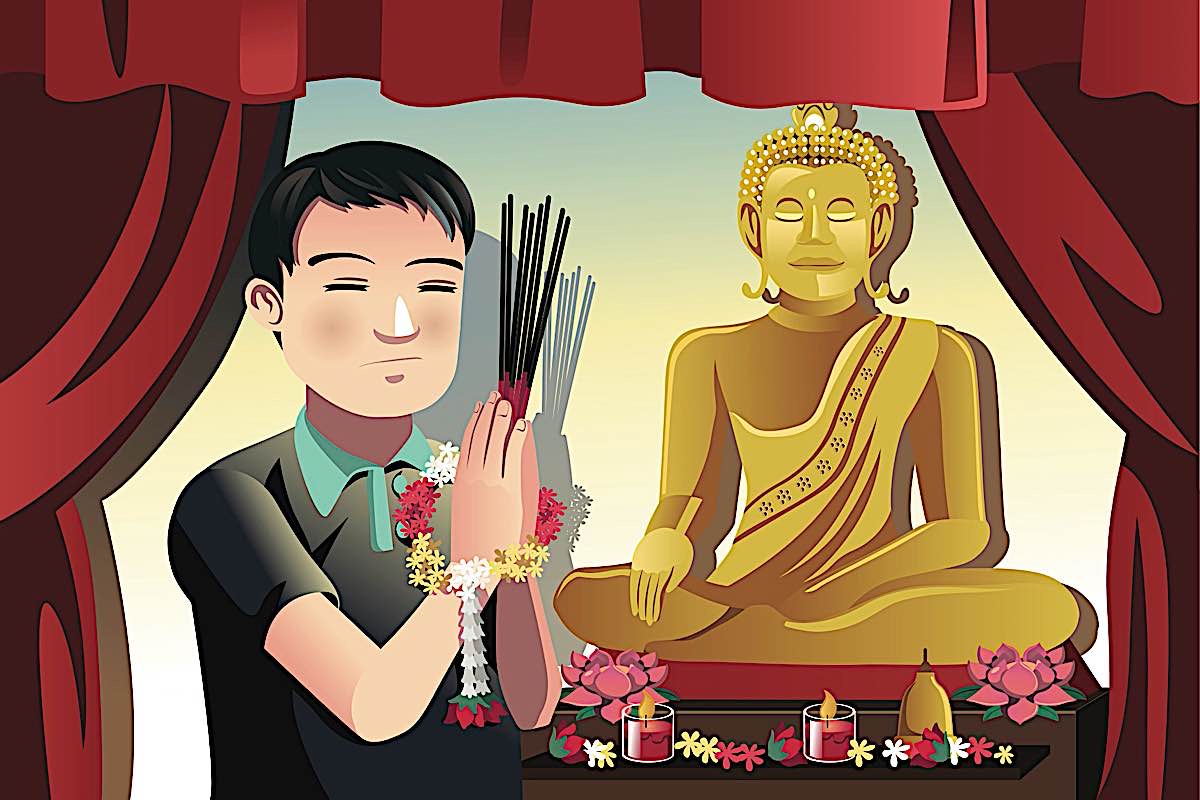
Devotion is the sauce of the part-timer
Sadhanas and meditation tend to be the secret sauce of the Buddhist yogi or yogini. However, for those of us not yet ready to retire to a cave in the mountains — the majority of Buddhists, in other words — prostrations, praise, pujas and, prayer are more likely to be the juicy dish of choice (to carry on the sauce metaphor). [For a feature on “saucy Sadhanas” see>>]

Sadhana and self-generation practices are advanced practices that require “dedicated retreat time” for most of us. Casual practice can reinforce the ego — if not tempered with an understanding of Emptiness and Bodhichitta motivation.
For this reason, Pujas, Praise, and Prayers — with love and devotion — can be the most effective way to connect with Dharma and to build the merit for “realizations” for those of us practicing “part-time.”
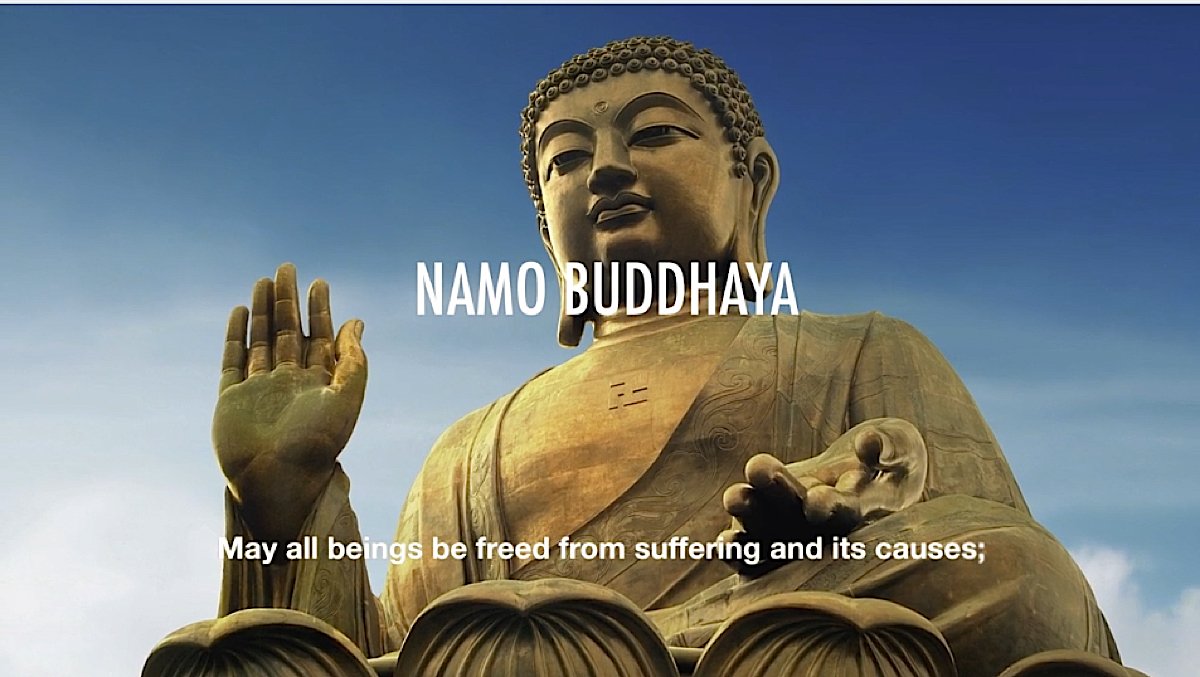
In fact, all advanced Sadhanas contain a substantial weight of praise and prayer — notably the Refuge, Bodhichitta aspiration and then the seven-limbs of practice — all as precursors to the actual self-generation meditation practices. These “limbs” include:
- Prostrations
- Offerings
- Confession
- Rejoicing in the Virtues
- Requesting the Turning of the Wheel of Dharma
- Requesting Teachers Remain
- Dedication of Merits.

Practicing loving devotion
It’s all wonderful and grand to think of “self-generating” as an idealized form, and visualizing yourself dissolving to “Emptiness” then rising as a Buddha. We call this our “practice,” not just because it’s our daily practice, but also as a nod to the reality that we are “practicing” — like a dress rehearsal. We visualize and meditate and aspire. We may have Buddha Nature, but most of us have a lot of hours in the metaphorical cave ahead of us before we develop true realizations. In the meanwhile, most of us must rely on praise, prayer, and prostrations for our purification and merit activities.
In other words, for many of us, the majority of our daily practice will inevitably involve praise, prayers, and prostrations.
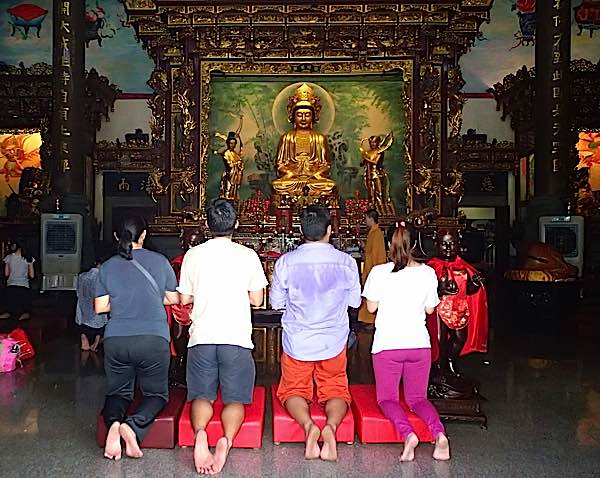
If that is the case, then, how are we to view the “deity”? Who are we praising? To whom are we praying? The modern “rationalizing” Buddhist would say “to our Higher Buddha Nature.” A devotional Buddhist would say, “to Buddha.” Who is right?
Who are we praising? A deity?
With analytical approaches to Buddhist practice, we tend to rationalize deities — or “devas” — as “metaphors” or archetypes. If we view the deity in this way, who is there to praise?

The great teacher Dzongsar Khyentse Rinpoche posed that question at a 2017 teaching on the 21 Taras:
“So you can’t help but ask “what is going on? Are we worshipping somebody? Are we worshipping 21 Taras? … So what is deity? … English words are so strange… “personification of a force” is the closest to what we mean by deva. The Tibetan word is Lha.
“So, anyway, what is the deity in tantric Buddhism? If I tell you not only will you not believe, you will not understand. If I say deity is everything, that is so abstract…
“…But I am actually telling the truth. See, this [holds up his sandal] is a deity. I’m serious. And don’t think it is because “Oh, it was worn by a Rinpoche.” No, no, not at all. Gyan, can you bring your chappal here? [Gyan holds up his shoe] Yes, he’s also holding a deity.
“Everything —the floor, the ceiling, the sky—everything is the deity.
“But more importantly, you, your nature, the absolute aspect of your self is the deity. But the problem is you don’t act like a deity.
“Do you act like a deity? You don’t act like a deity. You don’t think like a deity. You don’t look at things like a deity. You don’t swallow like a deity. You don’t listen as a deity. You don’t taste as a deity. You don’t move like a deity. You don’t chew like a deity. You understand what I’m saying? You don’t look like a deity. Look at you. I mean, look at me too. You don’t look like a deity. You don’t think like a deity. You don’t smell like a deity.”
“So you call yourself something else, even though you are actually the deity. And this is why we need to do something.
“What do we need to do? We need to actually approach this self deity. In the Tibetan, we call it nyenpa. Nyen means approaching. But before we approach this deity, you have to sort of like this deity. You have to long for it. You have to get excited. The feeling is important….”

Although Rinpoche has much more to say on the topic, which I strongly recommend you read, the point is we have to generate love, respect, adoration, admiration. Rinpoche ends with this point:
“After liking and admiring and longing for this deity—which is everywhere all around and actually is you—you need to chant, you need to pray.”
And, Rinpoche emphasizes the key point this way:
“This is the big game, by the way, the most interesting game. It’s a bit like: You are already where you want to be, but you don’t really know that, so you have to pretend that you are going where you already are.”
Dzongsar Khyentse Rinpoche teaching on the 21 Taras:
Aspirational Bodhisattvas
“Pretending” — as Rinpoche emphasized — for now, may well be the reality for those of us still working nine-to-five each day, with no option to retire from mundane living. We probably don’t have the time to transform our “pretend” into realizations — not yet.
A book by Dzongsar Rinpoche:

We can understand the advanced practices intellectually and philosophically, take initiations and instructions, and practice them, but we lack the one resource needed to exploit it right now — time. As long as we are suffering in samsara — without the hope of fully renouncing daily life — our main practices are foundational practices, designed to purify our karma and generate merit.
But, as Rinpoche explains — and as I highlighting at the beginning of this feature — it’s more important to “long for Her” — or your Yidam deity. In the same talk, he said:
“The devotees of Tara, especially the devotees from great universities like as Nalanda, they go bananas. They long for her, they praise to her, they really supplicate, they beseech her.”
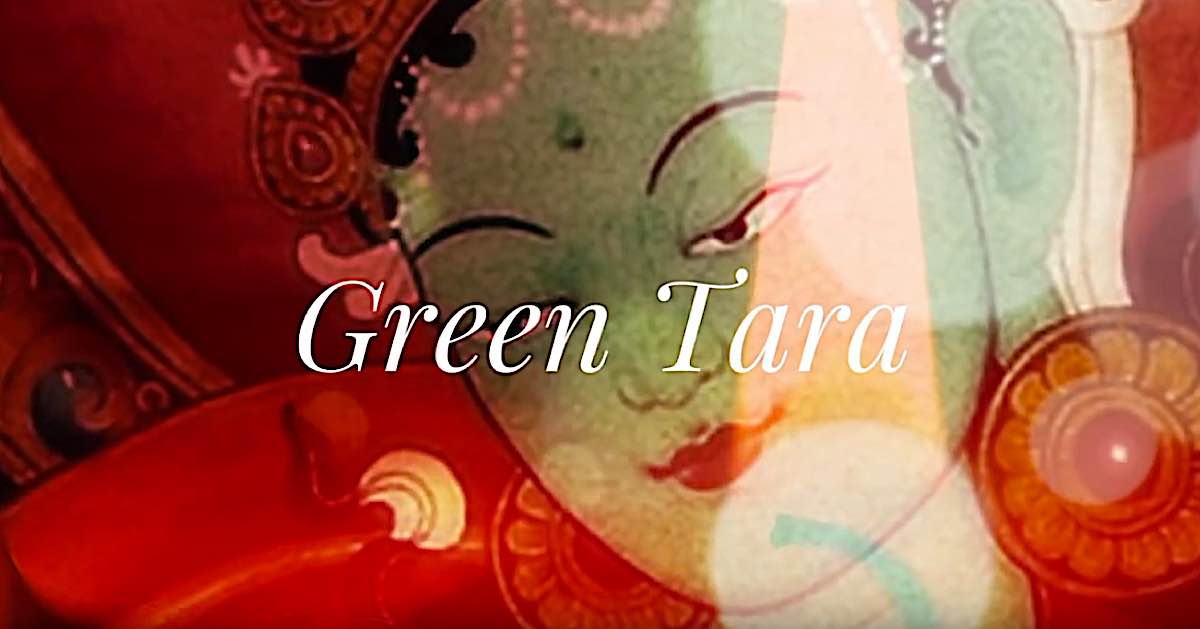
Longing and love and passion and wonder are methods. We need to praise, adore, pray, prostrate — not just for merit and purification, but to come closer to that ultimate truth that: “The deity is none other than the union of clarity and emptiness, the union of emptiness and compassion.” [2]
Logic and mapped foundational practices
This distracted lifestyle is also a reason, in Vajrayana Buddhism — a systemized approach where everything is logical and mapped out — that teachers try to introduce students to foundational practices such as Lamrim, before even offering empowerment in deity visualization. Unless we’re in a monastery — a nun or monk might be thought of as working on the path as a “full-time job” — we’re probably not ready for that step. At best we’re part-timers on the path. We may try to self-generate ourselves as “Green Tara” during the office conference call — a practice called “generating in daily life” as instructed by our teachers — but you can bet no one on that Zoom call sees Green Tara on their screen.

In other words, it’s important to intellectually understand and to practice — like dress rehearsals — our yogas, but as long as we’re part-time on the path, chances are we’ll progress faster on the path with foundation practices — like Lamrim — and especially: “Pujas, Praise and Prayers.”
Collecting empowerments and “burnout”
Does that stop us? Of course not. Most of us — myself included — tend to collect empowerments like trophies on our mantel. What do we do with them all, when we have empowerment in fifteen different practices? Do we really engage in fifteen sadhana visualizations every night — or even just once a week? (I know I don’t, sad to say!) Ultimately, this “practice overload” can lead to burnout, or at least “brownout.” The danger is, a sudden shut down when our internal circuit breaker blows.
It is for this reason, that the graduated path to Enlightenment — such as Lamrim — has always been the choice of teachers for their students. Even, for those of us with those fifteen empowerments, it is often best to “return to the foundation practices” as often as possible. It is through those practices that we can purify, and create the merit to make our practices really valuable.
“Even after twenty years, if you still feel like a ‘dharma baby’ still just starting out — and our dharma practice is so-so — why is this happening? In the ‘Wheel of Sharp Weapons’ it explained that it is partially our own laziness and procrastination… or your own cynical mind is blocking your progress… The remedy is just to practice diligently…”
— Venerable Zasep Rinpoche in a live-streamed Lo Jong teaching Nov 1, 2020 on YouTube>>
In the live teachings, Rinpoche quoted the remedy from the Wheel of Sharp Weapons (video below) (verse 40)
“When success in our practices always eludes us,
This is the wheel of sharp weapons returning
Full circle upon us from wrongs we have done.
Till now, deep within, we have clung to our ego,
Fully immersed in self-cherishing ways;
Hereafter let’s dedicate all of the virtuous
Actions we do, so that others may thrive. [1]
The video containing this teaching from the Wheel of Sharp Weapons as taught by Zasep Rinpoche:
The purpose of “self-generation” visualization is not to glorify the self. There’s no special status for practitioners who can generate as a Highest Yoga Tantra deity. The goal is the opposite. We are attempting to dismantle the ego — understand it’s dependent-arising true nature, it’s Emptiness.
To do so, to build the ego, is to misuse the Dharma. “We could abuse the Dharma. Don’t use the Dharma to reinforce Samsara,” said Zasep Rinpoche in the Lo Jong teachings. “This is why motivation is so important.”
Atisha’s great tradition: one deity and all the foundations
Atisha famously brought many traditions from India to Tibet, and probably most famously Lamrim. It is also Atisha, who admonished his Tibetan students that they didn’t need to practice dozens of aspects of Buddha (deities). Nearly all teachers recommend focusing with diligence and love on one special yidam — or aspect of the Enlightened Buddha.

Tulku Urgyen Rinpoche advised students to practice the “yidam they liked best… There are no essential differences between the yidams. You cannot say that there are good or bad yidams… People’s individual feelings do make a difference in that some people want to practice Padmasambhava as their yidam, while some want to practice Avalokiteshvara or Buddha Shakyamuni or Tara. The preference varies from person to person… The reason is that all yidams are essentially the same; they differ only on form, not essence.”

The scholar and teacher Alexander Berzin further clarifies in his commentary on Six Session Yoga:
“[We] have to remember that a Buddha – meaning ourselves when we become a Buddha – can manifest in any form, in any appearance… As Serkong Rinpoche, my teacher, said: Yamantaka can recite Om Mani Padme Hum. There isn’t any reason why Yamantaka can’t say Om Mani Padme Hum and is restricted to saying only his mantra. It’s not that he’s forbidden from saying anything else. And Yamantaka could also appear as Avalokiteshvara, as Vajrayogini, or as anything.”
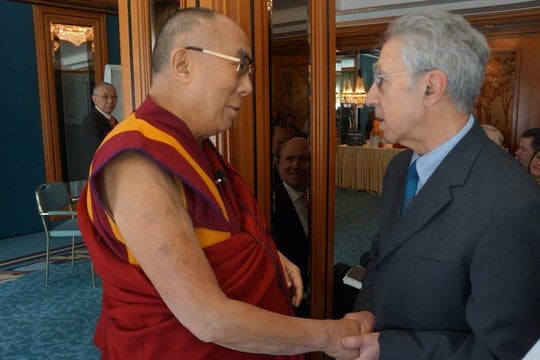
Traditionally, a practitioner chooses just one Yidam. All practices can then be “wrapped” within that one visualization without limitation. (For example, you can, depending on the instruction of your teacher, visualize all the Buddhas dissolving into your main Yidam, collecting all your practices into a core sadhana.)
More importantly, we invest in a relationship with one Yidam — all our love, focus, clarity, passion, devotion. It’s like a marriage. In a healthy marriage we may see other attractive people — and even befriend them — but we remain devoted forever to our one, true Yidam. To carry on with the metaphor, when we do “meet” other deities, it’s like best friends or friends, rather than our “soul mate.” We can love, and be loyal to many aspects of Enlightenment, but we tend to remain focused on our one, “heart deity” or Yidam.
A Prayer by Dzongsar Kyentse Rinpoche
This prayer was written as an aspiration to “pacify the Covid-19 pandemic”
Master Shayamuni, think of me!
Lord Khasarpani think of me!
Only father Odiyana Padma, think of me!
Only mother Tara, think of me!
Glorious sister Kali Devi, think of me!
Pay heed to this person’s prayers and desperate plea!
Purify the effects of negative actions,
Remove obstacles and adverse circumstances,
Free us from the grasp of malicious spirits,
Pacify the suffering of plague,
Destroy the root of destructive epidemics,
Pacify wars and disputes.
If I don’t pray to you, who else will pray!
If you don’t care for us with compassion, who will care for us!
If you don’t protect us with your power, who will protect us!
Bless us!
Bless us right now!
Bless us this very day!
Bless us this very moment!
Bless all beings that they encounter the Three Supreme Jewels,
Bless all beings that they have faith in the Three Supreme Jewels,
Bless all beings that they develop conviction in cause and effect,
Bless all beings the compassion and bodhichitta arise within them,
Bless all beings that they understand the meaning of shunyata,
Bless all beings that they recognize their mind as Buddha.
May this person’s aspiration be realized!
Buddhas and Bodhisattvas: You have vowed to ensure that such selfless prayers and please will be answered and fully accomplished.

NOTES
[1] Wheel of Sharp Weapons, A Mahayana Training of the Mind, by Dharmaraksita, translated by Geshe Ngawang Dhargyey. Pdf download available in English on Gaden for the West>>
[2] Deity Principle and Age of Tara, a talk by Dzongsar Khyentse Rinpoche at Deer Park Institute, Bir, India, April 2, 2017
More articles by this author

Buddhist body mandala practice in Vajrayana Buddhism — and riding the winds of the inner body “The prana goes where the mind goes.””

4 Guardians of the World and Dharma: the Watchers of the World: the Four Heavenly Kings in Buddhism, Their Mantras and Practice
Search
Latest Features
Please support the "Spread the Dharma" mission as one of our heroic Dharma Supporting Members, or with a one-time donation.
Please Help Support the “Spread the Dharma” Mission!

Be a part of the noble mission as a supporting member or a patron, or a volunteer contributor of content.
The power of Dharma to help sentient beings, in part, lies in ensuring access to Buddha’s precious Dharma — the mission of Buddha Weekly. We can’t do it without you!
A non-profit association since 2007, Buddha Weekly published many feature articles, videos, and, podcasts. Please consider supporting the mission to preserve and “Spread the Dharma." Your support as either a patron or a supporting member helps defray the high costs of producing quality Dharma content. Thank you! Learn more here, or become one of our super karma heroes on Patreon.
Lee Kane
Author | Buddha Weekly
Lee Kane is the editor of Buddha Weekly, since 2007. His main focuses as a writer are mindfulness techniques, meditation, Dharma and Sutra commentaries, Buddhist practices, international perspectives and traditions, Vajrayana, Mahayana, Zen. He also covers various events.
Lee also contributes as a writer to various other online magazines and blogs.
















